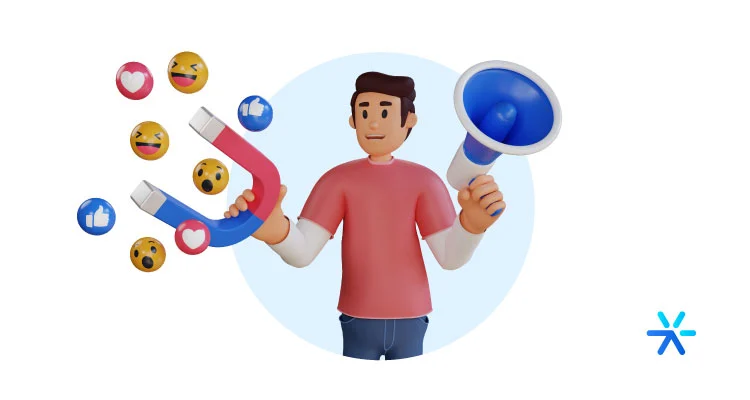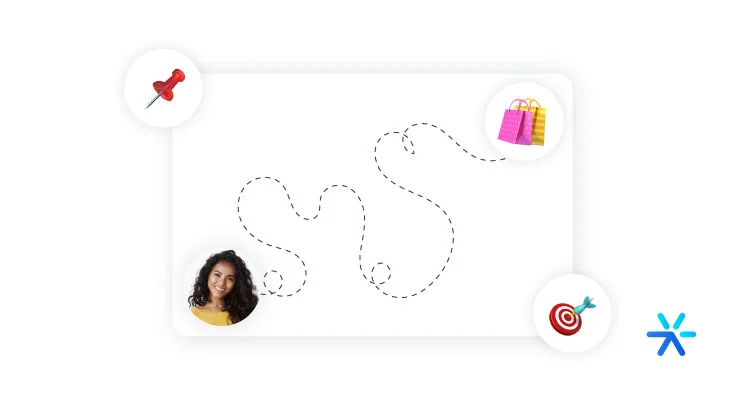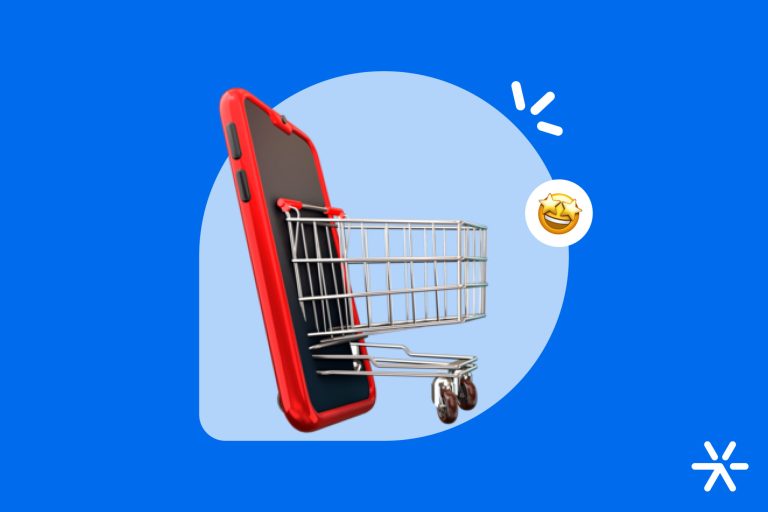What is Lead Nurturing and How to Create Your Nurturing Workflow
It all starts when you make a form or a chatbot available to collect basic user information.
Those who provide their contact information, such as name and email, become a lead.
But… What happens next?
Are leads directed to the sales page? Or to a scheduling form?
And what about those leads who, despite registering, didn’t become customers or even business opportunities?
That’s where the nurturing phase comes into play!
Lead nurturing is an essential strategy for your conversion and sales volume.
After all, a large portion of people doesn’t make a purchase the first time they visit your site.
If you still don’t have a plan to nurture your leads, guiding them through the buying journey, you’re certainly missing out on many sales.
Let’s see how lead nurturing will increase your lead conversion rate and help you sell more. 😉
What are leads?

Leads are people who provide their information to your company, becoming potential customers.
Anyone who provides their name and at least one contact method (like phone and email) is registered as a lead.
You can use a form to request this information or a more effective technology like a chatbot.
People may register to participate in a webinar, receive exclusive content, get a newsletter, or purchase a product or service.
What is lead nurturing?

Lead nurturing is the process of sending content of interest to your leads to warm them up.
In other words, nurturing a lead is inserting them into the buying journey, preparing the ground for the consumer to buy your product or service.
The nurturing strategy is mainly done via email, but other channels are becoming increasingly important, such as paid media (remarketing) and social media, especially WhatsApp.
Therefore, having an Email Marketing platform that sends messages in an automated way following the planned nurturing flow is essential.
But we can’t forget to take this content strategy to other media, mainly to make the customer relationship closer and more personalized.
By relying on marketing automation platforms, each message will be triggered based on the available data about the lead, considering their interests, engagement history, and other information that helps create segments.
In other words, lead nurturing is a process that ideally happens automatically and personalized according to segmented groups of your lead base.
Lead nurturing and conversion funnel
Lead nurturing has a great relationship with the conversion funnel.
The conversion funnel is the strategic definition of the stages the lead goes through until making a purchase.
Therefore, the more you understand the conversion funnel of your leads, the greater your ability to plan the nurturing of these contacts.
This is because each stage has specific objectives, aiming for leads to advance to the next phase of the funnel until making a purchase.
In other words, lead nurturing is an essential process to make your sales funnel work.
The content you send to leads at each stage will have the goal of making them progress in the buying journey.
So, creating lead nurturing strategies is the main way to make your leads progress through the stages of the conversion funnel.
Why is nurturing leads important?

Let’s better understand the importance of nurturing leads?
Besides serving to make them advance in the conversion funnel, nurturing leads has other advantages for your marketing strategy:
Educates the audience
Educating the audience is one of the greatest benefits of lead nurturing. 🙌
After all, nurtured and well-educated leads tend to make purchases 47% higher than non-nurtured leads, as shown by a study by Invespcro.
Often, leads that are still far from making a purchase are not necessarily disqualified.
They just haven’t considered the solution yet because they are unaware of the problem.
That’s why educational content about your segment and the pain your business solves helps your audience identify the problem.
After knowing and identifying it, the audience will be aware of a need.
The goal is for your leads to advance in the conversion funnel, but educating the general public is also an important step.
By promoting and creating content on social media, for example, you let the market know about the pain your company solves.
Known, discussed, and publicized, the value of your solution will reach more people and become increasingly recognized, opening more doors for the solutions your customer seeks, making them more confident when choosing.
Increases brand recognition
Increasing your brand recognition is another advantage of lead nurturing.
Regardless of the stage they are in, leads will come into contact with your brand every time they receive a nurturing content.
So, even if they are not ready to acquire a solution yet, your brand becomes familiar to them.
This recognition makes it more likely for them to engage in some action from your brand, click on an ad, or even mention your company in any context.
In other words, if you become more known, the chances of closing a deal increase.
This has already been proven in Invespcro’s study, which showed an 82% increase in the number of opportunities entering the pipeline after applying a lead nurturing strategy.
Saves time and pre-qualifies contacts
We already mentioned above that the lead nurturing strategy includes tools and automation of various stages of the process, meaning you’ll be saving your team’s time with more robotic and repetitive tasks, in addition to reducing the sales cycle.
From lead nurturing, you will already be in contact with leads, collecting more information, getting to know each consumer better, and segmenting them.
As proof of this importance, we can mention a survey by Salesmate, which revealed that nurtured leads have a 23% shorter sales cycle.
Assists in segmenting the lead base
Finally, a great benefit of lead nurturing is assisting in segmenting the lead base, as also shown by Invespcro’s research: nurturing improves prospect segmentation by 53%.
Throughout a nurturing flow, you can offer new materials, use lead enrichment strategies, or conduct surveys to obtain new data about your base contacts.
With each message sent, you will also have access to the opening and click data of leads.
With just this information, it is possible to create fundamental segmentations: cold leads and hot leads.
Cold leads
Those who open your emails infrequently, for example, are unlikely to respond to a promotional message about your product.
These are the leads you will place in a specific segmentation to send top-of-funnel content and more general approaches.
For those leads who converted a long time ago but never opened your messages again, you can create a reactivation segmentation.
For them, messages will focus on reminding them of your brand and solution.
Hot leads
On the other hand, those who open every email you send are highly engaged.
Those who always open and interact with your content are closer to conversion.
This is the segmented group to which you will begin sending messages from the next stages of the conversion funnel.
As they remain engaged, messages should become increasingly focused on your business solution.
If they engage with these more specific messages, there are great chances of converting them in some approach: it’s time to send them to the sales team.
However, don’t just consider the segmentations created with the nurturing flow to plan your actions.
Compare the engagement of these leads in nurturing messages with other data.
If you generate qualified leads, the information you have is valuable for creating segmentations in your nurturing flows.
Thus, you can optimize your messages and your nurturing flow, creating increasingly personalized approaches for each group of leads you have in your base.
Warms leads for the sales team
Sending leads to the sales team is a challenge for many companies.
The central question is: when is the ideal time to make an approach to sell?
Depending on your business model, you may adopt different criteria.
For example, companies with a sales development team (SDR) need to work with leads at an even earlier stage of the funnel, as the goal is to qualify these contacts and hand them over to the sales team only when they are ready to close a deal.
Nurturing flows are perfect for helping to determine the right time to pass a lead to the sales team.
In addition to observing the engagement rates of leads in each message, you can include triggers to identify when a lead is ready for this.
For example, a lead who interacted with a pricing page on your website is certainly more interested than someone who only downloaded a content material.
Therefore, the more data you have about your leads and the more segmented your nurturing flows, the more effective your sales team’s work will be.
This will make their approach more assertive, as they will talk to leads who are already engaged with your brand and have a greater chance of closing a deal.
7 fundamental steps of lead nurturing

Optimize your conversion
Before considering lead nurturing, it’s necessary to acquire qualified leads.
As mentioned above, lead qualification greatly aids in the nurturing process.
It’s not just about acquiring as many leads as possible.
You need to create strategies for optimized conversion, meaning attracting the right people to sign up and converting them into sales.
Conversion Rate Optimization (CRO)
CRO (Conversion Rate Optimization) is a strategy to increase your website’s lead conversion.
Your conversion rate is calculated by dividing the number of visitors by the number of converted leads.
Implementing CRO means converting more visitors into leads.
The higher your conversion rate, the more sales opportunities you’ll achieve, improving traffic generation results.
Thus, you can acquire more leads simply by optimizing your conversion strategies, without necessarily increasing your media budget.
With good CRO, you can reduce your Cost per Lead (CPL) and Customer Acquisition Cost (CAC).
Moreover, converting more leads by optimizing conversion, without paying to increase your traffic, will help reduce costs. Wondering why?
Improving your conversion rate increases your ROI, as with the same investment in traffic (whether paid or organic), you convert a larger number of leads.
In other words: a well-built CRO strategy, with the right tools, is an excellent optimization of your marketing investments.
Think about it, what’s more valuable:
- Paying thousands in ad tools and generating an insane volume of visitors to your site…
- … or optimizing your site’s CRO to convert more visitors into leads, qualifying them and placing them in a nurturing flow?
Of course, increasing traffic is also a central goal for your business’s growth.
But what’s the use of receiving huge traffic if a very low percentage of people are becoming leads?
What we invite you to reflect on is whether your site’s traffic alone is enough to increase your sales.
Does your site follow best practices to receive leads, attract their attention, qualify them, and convert them into actual sales?
If you want to sell more, you need to understand and apply conversion optimization.
Consider making CRO a priority in your marketing strategy.
Lead Qualification
For your lead nurturing to work best, lead qualification is an essential step.
Qualifying leads means, in short, determining if their reality and pain point align with your business solution.
Imagine this scenario: your solution is a payment gateway focused on processing online purchases with cashback.
Your differentiator is that any payment made via PIX refunds a percentage of the purchase value.
In this context, it doesn’t make sense to target leads from real estate or car dealerships: your solution won’t be valuable to these segments.
This is because transactions in these segments involve much higher values, often through negotiations, financing, and installments.
It’s more worthwhile to partner with and target companies with lower-value products, such as electronics stores.
Therefore, it’s essential to qualify leads before putting them into nurturing flows.
With the right questions, you’ll know if the lead is right for you.
If the lead’s interest is far from ideal, spare efforts trying to convert them. There simply isn’t a fit.
On the other hand, if the lead meets a minimum level of qualification but is still far from acquiring your solution, it’s worth including them in nurturing flows.
The more precise your lead qualification is, the simpler and more effective their nurturing will be.
This is a vast topic, as several factors determine how qualified a lead is:
- Your target audience and Ideal Customer Profile (ICP);
- Lead’s market segment;
- Number of employees;
- Monthly revenue;
- Number of site visits;
- Business model;
Among many other factors.
Build a robust lead database
This is one of the essential steps to grow your business: building a robust lead database.
However, having a robust lead database doesn’t guarantee results.
Firstly, you need to optimize conversion on your site, qualify your leads, and find the best attraction channels.
Only then can you build a robust lead database.
The more qualified leads close to your Ideal Customer Profile (ICP) you acquire, the easier it will be to nurture and convert them.
Therefore, the tip is: gradually create and build your lead database, focusing on your goals and target audience.
Quality outweighs quantity, especially for those starting with digital marketing.
Create the right segmentations
Based on your studies and strategic decisions, create lead segmentations.
Your strategy will depend on the current state of the company, your goals, and priorities.
Essentially, segmentations are made according to the following parameters:
- Personal information (age, gender, location);
- Engagement history (website visits/conversions/social media/events/contacts in general);
- Fit with ICP.
With this data, you can create groups and identify where they are in the sales funnel.
Don’t forget that the main goal of lead nurturing is to continue the sales funnel.
Therefore, think about materials, content, invitations, and messages that will be suitable for the selected group.
Plan nurturing flows and conduct tests
Get to work! Plan nurturing flows for each created segment and start conducting tests.
The time between messages in a sales cadence flow can vary greatly.
Too few messages will let the lead cool off.
On the other hand, sending messages every day will likely annoy the person and lead to unsubscribes.
For each email sent, you can create different versions of the subject line, the image (if any), or make small changes to the email text for an A/B test.
This way, you’ll identify the practices that work best with each group.
How to create a lead nurturing flow? In less than 10 steps, you’ll have a lead nurturing flow ready. Check it out:
- Determine who your persona is and which stage they’re at;
- Select which materials will be used and the order the flow will follow;
- Create the email and message flow using an automation tool;
- Pay attention to the email layout and language used in the messages;
- Use lead scoring to segment and send your nurturing flows;
- Lastly, monitor the action results and make improvements.
Craft compelling copy
This step in lead nurturing couldn’t be missing: craft compelling copywriting!
Although images quickly grab attention and interest, engaging text can have a great persuasive power.
Use good storytelling, combined with materials like case studies and data disclosure to captivate people.
You can also personalize your messages with a personal tone, using the person’s name (as a variable if you use a marketing tool), which makes the message more engaging.
And of course! Don’t skimp on time when thinking about your email or message subject line.
The subject line is the call to action, the text that makes the first impression. It will determine if your reader is interested enough to click and read the rest of the message.
Therefore, aim to use mental triggers in your subjects, as well as other copywriting techniques that aid in conversion.
Follow lead nurturing best practices
Following lead nurturing best practices is essential to ensure that your lead nurturing strategy is effective. Some of the best practices include:
- Personalization;
- Appropriate frequency;
- Relevant content;
- Effective CTA;
- Testing and optimization.
What not to do in lead nurturing?
Above, we showed what you can do; now let’s talk about what NOT to do in your lead nurturing strategy:
- Sending emails to groups (e.g., marketing@, sales@);
- Not cleaning your contact list;
- Not investing in paid media.
Email checklist
To wrap up the best practices stage, we have a checklist that you can follow when implementing your email strategy:
- Planning (materials, formats, frequency, target audience);
- Content (blog articles, e-books, infographics, webinars, etc.);
- Layout;
- Setting up and activating the flow;
- Review (this step is essential; you don’t want an email being sent to your contact base with a wrong link, for example);
- Analysis (open rate, conversion rate, and clicks).
Measure engagement and track results
To wrap up our lead nurturing flow step-by-step, we can’t forget about analyzing results and making constant adjustments.
Remember, it’s only through this monitoring that you’ll be able to make improvements and analyze if your strategy is yielding results or not.
Below, we list some metrics you can use to track your strategy:
Lead nurturing metrics to track:
- Open rate – the number of people who opened the message divided by the number of people who received it;
- Click-through rate – the number of clicks on a link divided by the number of people who received it;
- Conversion rate – the percentage of those who converted from the message;
- Unsubscribe rate – how many people unsubscribed from the email after the flow was sent;
- Messages marked as SPAM – number of users who marked the email or message as SPAM.
Best tools to help you in the process
Wrapping up our comprehensive content on lead nurturing in the best way, let’s go through marketing tools that will assist you throughout this process!
Lead generation tools
We’re talking about lead generators, responsible for capturing, qualifying, and segmenting leads.
Within this group, we can mention:
- Chatbots – Leadster;
- WhatsApp Button – Leadster;
- Landing Page and Form Builders – Unbounce;
- Pop-Up Creators – OptinMonster;
- Ad Platforms – Google Ads;
- Active Prospecting Tools – LinkedIn Sales Navigator.
If you’re unsure where to start, here’s a tip: Leadster’s Conversational Marketing platform might be your best bet. 😉
With it, you’ll have access to a marketing and sales chatbot with attractive calls, highly personalized flows, automatic pre-qualification, and intelligent distribution.
Moreover, you also get WhatsApp routing, performance dashboard, A/B testing capabilities, automatic meeting scheduling, and lead location tracking.
Test it free today for 14 days, no credit card required!
Ready to start your lead nurturing process?







